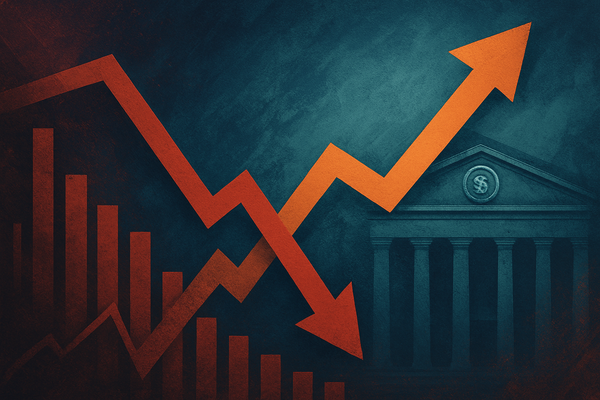Goldman Sachs Sounds Alarm: Is a "Lost Decade" Looming for US Stocks?

Goldman Sachs (NYSE: GS) has issued a stark warning to investors, presenting a compelling case for a "lost decade" in US equities. The influential investment bank suggests that the S&P 500 (NYSEARCA: SPY) is poised for significantly lower returns over the next ten years compared to the robust performance witnessed in the preceding decade. This sobering outlook urges a fundamental re-evaluation of investment strategies, particularly regarding allocation to US assets versus international markets.
The immediate implications of Goldman Sachs' pronouncement are profound, prompting investors to temper their expectations for future US stock returns. Rather than the double-digit gains many have grown accustomed to, the firm anticipates annual returns potentially in the low single digits. This forecast underscores the critical need for increased international diversification, with emerging markets and Asian stocks highlighted as regions with more favorable valuations and stronger earnings prospects. Investors are also encouraged to broaden their diversification across various asset classes, including bonds, to mitigate potential weaknesses in US equities and consider adaptive investment strategies in what could be a more range-bound market.
The Bearish Thesis: High Valuations, Concentration, and Fading Tailwinds
Goldman Sachs' pessimistic forecast for US equities is meticulously constructed upon several key pillars, painting a picture of an overextended market facing significant headwinds. A cornerstone of their argument revolves around the historically elevated valuations of US stocks. The S&P 500's cyclically adjusted price-to-earnings (CAPE) ratio, a long-term valuation measure, currently resides in the 97th percentile since 1930, indicating a market "priced for perfection" with limited upside potential. History, according to Goldman Sachs, suggests that high starting valuations invariably lead to lower forward returns.
Adding to the concern is the unprecedented level of market concentration within the US equity landscape. A handful of megacap technology companies dominate the S&P 500, a phenomenon not seen in a century. This heavy reliance on a few behemoths increases the index's risk profile and makes overall performance highly susceptible to the fortunes of these specific firms. Furthermore, Goldman Sachs projects limited earnings growth potential for the US market, with annualized earnings per share growth for the S&P 500 anticipated to be around 6%, but with concerns about the sustainability of high sales growth across a broad base of companies.
The investment bank also points to the fading of powerful tailwinds that propelled S&P 500 performance over the last decade. Factors such as expanding profit margins, lower corporate taxes, and persistently low interest rates are expected to have a diminished impact going forward. Compounding these issues, Goldman Sachs anticipates an increase in economic contractions within the US over the next ten years, forecasting four GDP contractions compared to just two in the preceding decade. Such economic slowdowns have historically correlated with negative annualized equity returns. Finally, rising US Treasury yields are presented as a significant competitive force against equities. As "risk-free" returns from bonds become more attractive, especially against the backdrop of elevated stock valuations, the appeal of stocks diminishes, with Goldman's model suggesting a 72% probability that the S&P 500 will underperform bonds in the coming decade.
Navigating the Shifting Sands: Potential Winners and Losers
A "lost decade" for US stocks, as envisioned by Goldman Sachs (NYSE: GS), would undoubtedly reshape the landscape for public companies and investors, creating distinct categories of potential winners and losers. The most immediate impact would likely be felt by the megacap growth stocks, particularly in the technology sector, which have largely driven the S&P 500's (NYSEARCA: SPY) performance over the past decade. Companies like Apple (NASDAQ: AAPL), Microsoft (NASDAQ: MSFT), Alphabet (NASDAQ: GOOGL), Amazon (NASDAQ: AMZN), and Nvidia (NASDAQ: NVDA), due to their outsized influence on the market-cap-weighted index, could face significant headwinds if their high valuations struggle to justify future growth in a lower-return environment. Their premium multiples may compress, leading to underperformance.
Conversely, the call for increased international diversification suggests that companies in emerging markets and developed markets outside the US could emerge as relative winners. Firms in regions such as Europe, Japan, Asia ex-Japan, and broader emerging markets are projected by Goldman Sachs to offer superior annualized returns. This shift in capital flows could benefit large multinational corporations based in these regions, as well as local companies with strong fundamentals and more attractive valuations. Investors might seek out opportunities in European industrial giants, Japanese technology innovators, or rapidly growing consumer and tech companies in Asian markets.
Within the US, a "lost decade" scenario could favor value-oriented companies and those with strong balance sheets that consistently generate free cash flow and pay dividends. Sectors traditionally associated with value, such as utilities, consumer staples, and certain industrials, might become more attractive as investors prioritize stability and income over aggressive growth. Furthermore, companies less sensitive to economic cycles or those with robust competitive moats could prove resilient. On the other hand, highly leveraged companies, speculative ventures, and businesses reliant on continuous capital infusion for growth may struggle significantly in an environment of constrained returns and potentially higher interest rates. The emphasis on equal-weighted indices also suggests that smaller, often overlooked US companies outside the megacap sphere could see a relative uplift in performance compared to their larger, overvalued counterparts.
Broader Implications: A Paradigm Shift in Global Finance
Goldman Sachs' (NYSE: GS) "lost decade" thesis extends far beyond mere stock market predictions; it signals a potential paradigm shift in global finance with wide-ranging implications. This outlook suggests a significant deceleration from the era of hyper-globalization and ultra-low interest rates that largely defined the past few decades. The forecast of increased economic contractions in the US, combined with fading tailwinds like expanding profit margins and low corporate taxes, points to a more challenging macroeconomic environment globally. This could lead to a re-evaluation of growth strategies for multinational corporations, potentially shifting focus from aggressive expansion to efficiency and resilience.
The anticipated underperformance of US stocks relative to global counterparts aligns with a broader trend of de-dollarization discussions and the increasing economic influence of emerging markets, particularly in Asia. This could accelerate capital flows away from traditional Western financial hubs, bolstering the development of financial markets in regions like China, India, and Southeast Asia. Regulatory bodies worldwide might also begin to scrutinize market concentration more closely, especially if the dominance of a few tech giants becomes a systemic risk in a lower-return environment. Historically, periods of prolonged market stagnation, such as Japan's "lost decades" following its asset bubble burst in the early 1990s, have necessitated significant structural reforms and shifts in investment philosophy. While the US context differs, the historical precedent underscores the potential for deep-seated changes in corporate strategy and investor behavior if the "lost decade" materializes.
Furthermore, the rising competition from US Treasury yields introduces a critical re-evaluation of the equity risk premium. If "risk-free" returns become consistently more attractive, it fundamentally alters the calculus for allocating capital to riskier assets like stocks. This could lead to a resurgence in fixed-income investing, potentially impacting the cost of capital for corporations and influencing corporate finance decisions. The forecast also implicitly challenges the long-held belief in the inherent superiority of US market returns, pushing investors to adopt a more globally diversified and nuanced approach to portfolio construction, moving away from a predominantly US-centric bias. This could foster greater innovation in international investment products and strategies, as asset managers seek to capitalize on the projected outperformance of non-US markets.
What Comes Next: Navigating a New Investment Landscape
The coming years, under Goldman Sachs' (NYSE: GS) "lost decade" prognosis, promise a dramatically different investment landscape, demanding strategic pivots and adaptive approaches from both corporations and investors. In the short term, markets may experience heightened volatility as investors grapple with adjusted return expectations and reallocate capital. We could see continued rotation out of highly valued growth stocks into more defensive or value-oriented sectors, both domestically and internationally. Companies with strong balance sheets, consistent cash flow generation, and robust dividend policies may find favor, as investors prioritize stability and income in a lower-growth environment.
Long-term possibilities include a sustained period where active management and rigorous stock selection become paramount, as broad market beta returns diminish. This environment could also accelerate the trend towards private markets, real estate, and alternative investments, as institutional investors seek uncorrelated returns and higher alpha opportunities outside of public equities. For corporations, the emphasis might shift from aggressive M&A and growth-at-all-costs strategies to capital efficiency, deleveraging, and shareholder returns through buybacks or dividends. Companies that can innovate effectively while maintaining fiscal discipline will be best positioned to weather the storm.
Market opportunities may emerge in regions projected to outperform, such as emerging markets and specific developed markets like Japan and Europe. Investors willing to undertake thorough due diligence and navigate geopolitical complexities could find compelling valuations and growth stories in these areas. Furthermore, sectors benefiting from long-term structural trends, such as renewable energy, infrastructure, and certain healthcare innovations, might still offer pockets of growth regardless of broader market performance. The primary challenge will be adjusting to a reality where US equities no longer offer the easy, outsized returns of the past, necessitating a more granular, globally diversified, and patient investment philosophy.
Comprehensive Wrap-up: A Call for Strategic Rethinking
Goldman Sachs' (NYSE: GS) "lost decade" thesis for US stocks represents a critical inflection point, urging a comprehensive rethinking of investment strategies and expectations. The key takeaway is clear: the era of seemingly effortless double-digit returns from a US-centric equity portfolio may be drawing to a close. Elevated valuations, unprecedented market concentration, diminishing economic tailwinds, and rising competition from fixed income are converging to create a challenging environment where US equities are projected to significantly underperform global peers over the next decade.
Moving forward, the market is likely to be characterized by lower overall returns, increased volatility, and a greater emphasis on fundamental analysis and diversification. Investors should proactively adjust their portfolios, prioritizing international exposure, particularly to emerging markets and certain developed markets outside the US, where valuations are more attractive and growth prospects appear stronger. A broadly diversified approach across asset classes, including a renewed appreciation for bonds, will be crucial for managing risk and achieving more stable returns.
What investors should watch for in the coming months includes any shifts in corporate earnings growth trends, particularly among the megacap technology firms that heavily influence the S&P 500 (NYSEARCA: SPY). Monitoring global economic data, interest rate policies from central banks, and geopolitical developments will also be essential, as these factors will heavily influence capital flows and market sentiment. Ultimately, Goldman Sachs' outlook is a call to action: to move beyond complacent assumptions and adopt a more strategic, globally informed, and patient approach to investing in a potentially less forgiving market environment.
This content is intended for informational purposes only and is not financial advice



